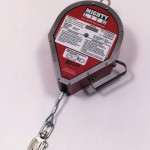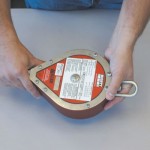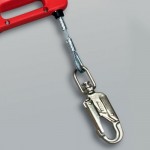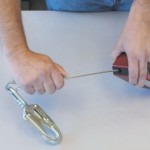Self-Retracting Lifeline Inspection: What To Look For On A Daily Basis
 Inspections are essential in making sure your fall protection systems perform correctly. To ensure that your personal protective equipment is in good working order, and will protect you from injury in the event of a fall, your self-retracting lifelines (SRLs) should be inspected daily before each use. Remember, if you are the one using the PPE, it is your life on the line, and that means you are the one responsible for checking it every day before trusting it with your life.
Inspections are essential in making sure your fall protection systems perform correctly. To ensure that your personal protective equipment is in good working order, and will protect you from injury in the event of a fall, your self-retracting lifelines (SRLs) should be inspected daily before each use. Remember, if you are the one using the PPE, it is your life on the line, and that means you are the one responsible for checking it every day before trusting it with your life.
Once a year, a Competent Person should do a complete inspection of your SRLs and all other fall protection equipment, in coordination with the managing properties or safety departments within your organization. Any damaged or outdated equipment should be immediately removed from service and replaced.
But you shouldn’t rely entirely on yearly inspections to make sure that self-retracting lifelines and other fall safety equipment is in working order. As we explained in a previous blog article, all fall protection equipment deteriorates over time. Ordinary use produces wear and tear on SRL cables and other elements.
Also, environmental conditions such as extreme heat or cold, salt water, and everyday weather can take a toll on fall protection equipment, causing it to lose its effectiveness over time. Some types of fall equipment elements will break down even faster in corrosive environments. For example, SRLs with web lifelines made from nylon/polyester webbing will deteriorate faster than SRLs with steel cable lifelines.
That’s why it’s important for users to do a daily inspection of their SRLs. Over the course of a year between annual inspections by a Competent Person, equipment can be damaged or lose its effectiveness due to high use. A daily inspection of the SRL will ensure that the components of the self-retracting lifeline still work, and are still sound and able to protect the user from injury. All PPE, including both the harness and the SRL, lanyard or other connecting device should be immediately removed from service after it has been involved in a fall, regardless of whether any damage is apparent.
Inspecting SRLs for Damage
To quickly review, a self-retracting lifeline works like a seat belt. The lifeline cable is attached to the back of the worker’s body harness, so that it “plays out” from the SRL housing as the worker moves away from the anchor point. If the worker falls, a locking device inside the housing locks up the cable, and arrests their descent within 8 or 9 inches. It then absorbs the shock of the fall and decelerates the worker, stopping them within 3 1/2 feet.
 In doing your daily inspection, you should first inspect the SRL housing, to make sure there are no dents, cracks, or puncture marks in it. Any damage to the housing may mean that the locking and shock-absorbing mechanisms inside are also damaged. If the interior components are damaged, the SRL may not lock up or adequately absorb the shock of the worker’s fall in order to stop them in time.
In doing your daily inspection, you should first inspect the SRL housing, to make sure there are no dents, cracks, or puncture marks in it. Any damage to the housing may mean that the locking and shock-absorbing mechanisms inside are also damaged. If the interior components are damaged, the SRL may not lock up or adequately absorb the shock of the worker’s fall in order to stop them in time.
You should check to make sure that the caribiner snap hook on the end of the SRL is in working order. It should be able to self-close and lock, and should be a dual-action snap hook. You should need to operate two separate locking mechanisms on the snap hook in order to open it.
 Next, you should slowly pull the cable out all the way. Make sure there are no cuts, tears, or fraying in the steel or web cable fibers. Watch out for kinks, burrs, broken fiber strands, or any corrosion, abrasions, discoloration, or other types of wear and tear damage.
Next, you should slowly pull the cable out all the way. Make sure there are no cuts, tears, or fraying in the steel or web cable fibers. Watch out for kinks, burrs, broken fiber strands, or any corrosion, abrasions, discoloration, or other types of wear and tear damage.
If you’re working in a corrosive environment, look for signs that the cable has been recently damaged by environmental elements. For example, if you’re working in a high heat work area, such as a steel mill or foundry, look for signs of heat scorching on the cable or housing. If you’re working in an area where industrial chemicals are being used, look for acid or chemical burns.
Also, make sure there is no “bird nesting” in the steel or web cable. “Bird nesting” is when a cable gets bent out of shape or tweaked in a weird way, so that the cable fibers literally look like a bird’s nest.
As the retracting device pulls the cable back into the housing, make sure there is tension on the cable. If the cable doesn’t retract all the way by itself, you will run into a problem where the locking mechanism doesn’t lock up correctly, and may not arrest a worker’s momentum before they hit the ground.
 Finally, pull the cable out and give it a good yank. Make sure the locking mechanism inside the housing responds to a sudden jerk on the cable. The SRL should lock up like a seat belt does when your car comes to a sudden halt. Do that three or more times with the cable at different lengths.
Finally, pull the cable out and give it a good yank. Make sure the locking mechanism inside the housing responds to a sudden jerk on the cable. The SRL should lock up like a seat belt does when your car comes to a sudden halt. Do that three or more times with the cable at different lengths.
If you find any damage, deterioration, or defects in your SRLs, you should remove them from service immediately, in accordance with OSHA regulations (OSHA 29 CFR 1910.66 and 1926.502). You should return any damaged SRLs or other equipment to FallProof Systems for repair or replacement.
In our fall protection training courses, we stress the need for workers to do daily inspections of SRLs, but safety managers need to enforce it on the job. Your safety managers should continuously remind users to do their daily inspection. They should make it a daily requirement, not just something that should be done occasionally.
IMPORTANT NOTE: This article is for information purposes only. It should not be considered a substitute for proper worker training in the use of fall protection equipment, or for Competent Person training in inspection of fall protection equipment. Also, even if your workers do consistent daily inspections of their SRLs, you should still schedule an annual inspection of all equipment by a Competent Person.

